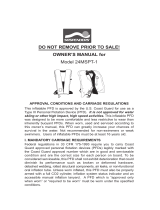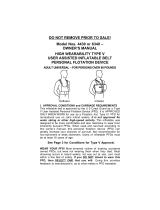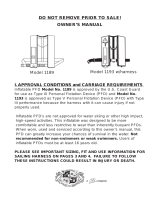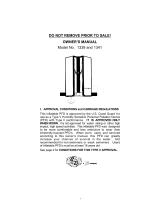Page is loading ...

Inflatable PFD Owner’s Manual
MD3025NV Manual Inflation Pouch Model
USCG Approved Type V,
Approved Only When Worn,
Special Use Device

DO NOT REMOVE PRIOR TO SALE.
This device will not inflate automatically upon immersion.
Tab must be pulled to activate inflation mechanism.
APPROVAL CONDITIONS AND CARRIAGE
REGULATIONS
This inflatable PFD is approved by the U.S.
Coast Guard for use as a Type V Personal
Flotation Device (PFD). It is not approved for
water skiing or other high impact, high speed
activities. This inflatable PFD was designed
to be more comfortable and less restrictive
to wear than inherently buoyant PFDs.
When worn, used, and serviced according
to this owner’s manual, this PFD can greatly
increase your chances of survival in the
water. Not recommended for non-swimmers
or weak swimmers. Users of inflatable PFDs
must be at least 16 years old.
A Type V PFD must be worn to count as an approved PFD.
p1

MANDATORY CARRIAGE REQUIREMENTS
Federal regulations in 33 CFR 175-1993 require you to carry Coast
Guard approved personal flotation devices (PFDs) legibly marked with
the Coast Guard approval number which are in good and serviceable
condition and are the correct size for each person on board. To be
considered serviceable, this PFD shall not exhibit deterioration that could
diminish its performance such as broken or deformed hardware, detached
webbing, rotted structural components, air leaks, or nonfunctional oral
inflation tube. Unless worn, this PFD must also be properly armed with
a full CO2 cylinder, inflation system status indicator, and an accessible
manual inflation lanyard. A PFD which is “approved only when worn” or
“required to be worn” must be worn under the specified conditions.
What is an Air-only PFD?
While traditional PFDs are inherently buoyant, air-only PFDs rely
entirely upon inflation for buoyancy. Uninflated, the inflatable PFD is
a comfortable, waist belt pack that can be inflated at any time with
a 33 gram CO2 gas cylinder. The inflatable PFD is designed to meet
the demands of a full protection PFD offering maximum mobility with
minimum bulk. The inflatable PFD can be inflated either manually
by jerking a pull tab, or orally by mouth. It is recommended that you
familiarize yourself with the procedures outlined in INSTRUCTIONS FOR
USE.
INSTRUCTIONS FOR USE
Sizing and Fit
The PFD provides 33.7 lbs of buoyancy and is designed for wearers with
a chest range of 30-52 inches weighing over 80 pounds.
p2

Check Your Inflatable PFD
Before Using it
After purchasing your inflatable PFD, make sure it
has an unused 33 gram CO2 cylinder attached to
the inflator mechanism (Fig. 1a).
Check the components and how to assemble the
inflator by following these steps:
1) Undo the Velcro
™
flap on the back side of the
pouch to expose the bladder and inflator (Fig.
1b).
2) Unscrew and remove the CO2 gas cylinder
from the inflator and inspect its small end. If it
is pierced, replace it! (Fig. 1c).
3) Make sure the manual lever is in the
up-and-ready position and insert the green
indicator pin if not already in place. Make sure
the CO2 cylinder is screwed hand tight into
the inflator (Fig. 1a).
4) Check that the oral-inflation dust cap is
properly in the stowed position (Fig. 1d)
p3
Fig. 1a
Fig. 1b
Fig. 1c Fig. 1d

5) Repack the bladder into the pouch (see “Repacking your inflatable
PFD”). Make sure the pull tab is hanging freely outside the pouch. If
everything checks out according to the preceding instructions, your
inflatable PFD is ready for use.
Donning Instructions
It is important that the PFD is properly adjusted to fit the person wearing
it. An incorrect fit or improper fastening of attachments could impede its
effectiveness.
1) All belts and straps are already threaded correctly and only need
to be adjusted for fit. The MD3025NV waist belt should fit securely
below your rib cage.
2) Put the inflatable Pouch PFD on just like a standard waist belt pack,
and fasten the front buckle. Adjust waist belt to a snug, comfortable
fit, and secure the belt’s loose end in the belt loop. Do not wear
inflatable PFDs under clothing, as the inflation could be restricted, or
you could be injured (Fig. 2, Steps 1 and 2).
p4
Fig. 2

Deployment and Use of the PFD (Fig. 2, Steps 3-6).
Inflating then donning
1) Either pull on the yellow strap to bring out the bladder, then inflate
orally, or pull sharply on tab to inflate.
2) Put over head.
3) Tie the tie tapes at neckline.
Donning then inflating
1) Pull on the yellow strap to bring out the bladder
2) Put over head.
3) Pull sharply on tab to inflate or inflate orally.
4) Tie the tie tapes at neckline.
Inflating Your PFD
It is recommended that the following procedures are followed to inflate
your PFD:
1) Manual inflation
Actuate the inflation system by jerking firmly downward on the pull
tab. The PFD should fully inflate within 5 seconds (Fig. 3a).
2) Oral inflation
Properly armed and inspected, manual inflatable PFD models will
inflate. However, should inflation not occur, or in a non-emergency
situation, you can fully inflate the PFD by mouth (Fig. 3b). To orally
inflate the PFD, first pull on the yellow strap to bring out the bladder
and locate the oral inflation tube on the wearer’s left front panel of
the PFD. Then remove the dust cap from the end of the oral tube and
blow into the tube until the PFD is fully inflated.
p5

Information: The carbon dioxide used to inflate PFDs will
slowly permeate through the fabric cell over time. A slight
reduction of pressure will be observed after several hours
of inflation. Topping up by oral inflation may be required
in the event of very prolonged immersion.
Rearming Your PFD After Manual Inflation
1) Unscrew and inspect the CO2 cylinder. If used or damaged, discard
the CO2 cylinder (Fig 1c).
2) Check the manual lever to ensure it is in the up and ready position
with the green indicator pin properly installed. If the green indicator
pin is missing or damaged, replace it (Fig. 4a).
3) Install an unused CO2 cylinder by screwing it into the top of the
inflator and hand-tighten. Do not
over-tighten, as this can damage
the internal gasket.
4) Refold the PFD in accordance with
the repacking instructions in the
Owner’s Manual.
Your PFD is now ready for use.
p6
Fig. 3a
Fig. 4a
Fig. 3b

Deflating the Buoyancy
Cell
To deflate the buoyancy cell, reverse the
oral-inflation tube dust cap and insert it into
the valve or depress valve with fingertip. The
dust cap will not lock in the deflate position
so it is necessary to hold it in place (Fig.5).
Gently squeeze the cell until all air or gas
has been expelled. Put the inflation tube
dust cap back in its normal position on the
oral inflation tube (Fig.1d).
Repacking Your Inflatable PFD
Before repacking, completely deflate the inflation cell. Force excess
air out through the inflation tube (Fig. 5). Do not wring cell. Put the
inflation tube cap back in the normal stowed position
(Fig. 1d).
Note: Before following the repacking sequence, be sure to
properly rearm your inflatable PFD .
Warning: Ensure the lanyard and pull tab are not twisted around the
inflator or cylinder before re-packing. Ensure attachment webbing,
between the bladder and pouch, is not twisted before re-packing.
1) Lay the bladder and pouch out on a flat surface with the bladder’s
inflator and oral tube facing the flat surface (Fig.6a).
2) Fold the bladder into thirds using the dotted lines printed on the
bladder. Start with Fold #1, then Fold #2. Ensure the tie tapes and
whistle are folded in (Fig.6a).
3) Starting at the top of bladder, make your next fold at the dotted line
screened on the bladder (Fig 6b, Fold #3). Fold on the next dotted line
(Fold #4). Continue folding the bladder toward the pouch (Fig.6c).
p7
Fig. 5

4) Without twisting, fold the bladder over once and place into the center
of the pouch between the two wings (Fig.6d). Ensure the yellow
inflator pulltab is positioned so it hangs out from the upper left hand
corner (above left side wing).
5) Fold both side wings on top of the bladder and secure wingtips
together with Velcro
™
at ends. (Fig.6d)
6) Fold the lower flap up and secure both side edges to wings with
Velcro
™
. (Fig.6d)
7) Fold the upper flap down onto the lower flap and secure with the
Velcro
™
running across the width of the pouch (Fig.6d). Ensure the
yellow inflator pulltab is still hanging out of the upper left corner
(lower right corner when donned as in Fig.6e).
p8
Fig. 6a Fig. 6b Fig. 6c
Fig. 6d Fig. 6e

Usage Below Freezing
When the temperature is below freezing, a fully discharged
cylinder may not adequately inflate your PFD. Do not
use your PFD under these conditions unless it is already partly inflated.
Warning: CO2 inflation could over-pressurize and
damage your PFD if already fully orally inflated.
IS YOUR PFD IN GOOD AND SERVICEABLE
CONDITION?
Check your PFD between outings to be sure that it is properly armed;
that it is free of rips, tears or holes; that all seams are securely sewn; and
that the fabric, straps and hardware are still strong. Inspect the inflatable
portion of the PFD in accordance
with the CARE AND MAINTENANCE INSTRUCTIONS.
CARE AND MAINTENANCE INSTRUCTIONS
The buoyancy cell and inflation system should be checked at least
every three months. In addition, the following maintenance should be
performed after each time you wear or inflate the PFD.
1) Remove and inspect the CO2 cylinder from the inflator.
2) Check all components for dirt or corrosion. Clean or replace.
3) Check that the CO2 cylinder has not been pierced. Replace with
Mustang 33 gram CO2 cylinder if necessary (contained in inflatable
accessory pack MA7170.)
4) Check the manual lever to ensure it is in the up and ready position
with the green indicator pin properly installed.
p9

5) To check the oral inflation valve, fully inflate PFD and hold valve
under water. If bubbles appear, deflate and reinflate to test again.
Should the leak persist, take your inflatable PFD to your
dealer for proper servicing.
6) Visually examine your PFD for damage or excessive abrasion, wear,
tear or contamination. Particular attention must be paid to the
stitching. If in doubt, send it to your Mustang dealer for evaluation
and/or servicing.
7) Reassemble inflation system parts and repack PFD as outlined in
previous instructions and illustrations.
Leak test: Every three months the PFD should be tested for
general leakage by orally inflating your inflatable PFD until firm and let
stand overnight. A leaking PFD will not hold its firmness and should be
replaced.
Warning: If you are not confident in the self inspection and
servicing of your PFD, in accordance with these
instructions,
take your inflatable PFD to a Mustang dealer for
professional
servicing or contact Mustang Survival (see contact
information on back of manual).
Mustang Inflatable PFD Safety Accessories
MA-7170 33 gram CO2 replacement cylinder and green indicator pin.
p10

Cleaning and Storing Your Inflatable PFD
To clean your inflatable PFD, remove the CO2 gas cylinder. Hand wash or
sponge down in warm, soapy water and rinse with clean water.
Hang to dry on a plastic coat hanger. Be sure to replace CO2
cylinder. See Rearming Your PFD After Manual Inflation.
Always store your Inflatable PFD in a warm, dry place out of direct
sunlight.
WHY ARE PFDS REQUIRED SAFETY
EQUIPMENT?
Drownings are the leading cause of fatalities involving recreational
boating. A PFD provides flotation to help keep your head above water,
help you to stay face up in the water, and increase your chances for
survival and rescue. Most adults only need an extra 7 to 12 pounds
of flotation to keep their heads above water. The proper size PFD will
properly support the weight of the wearer.
Since this inflatable PFD does not have inherent buoyancy, it
provides flotation only when inflated. Familiarize yourself with the use of
this PFD so you know what to do in an emergency.
p11

How and Why to Test your PFD
Inflate your PFD and try it out in the water to:
· Make sure it floats you:
Comfortably (when worn properly)
Adequately for expected wave conditions
(Body shapes/densities affect performance)
· Make sure it works:
A flow of bubbles should not appear (see CARE AND
MAINTENANCE INSTRUCTIONS for leak tests)
It should inflate quick and easily.
· Learn how it works by:
Activating the CO2 inflation system
Rearming the CO2 inflation system
Using the oral inflator tube
The U.S.Coast Guard recommends that you purchase two
rearming kits. One to be used immediately in testing the inflation system
(see HOW DO YOU TEST YOUR PFD USING THE MANUAL
INFLATOR?) and the other to carry on board as a spare.
The only check of the
manual inflation system
(with CO2 cylinder and
green indicator pin removed)
would be to determine that
the lever arm and piercing
pin move freely when
moving the lever (attached
to the pull tab) several times
down and up.
p12

How do you Test your PFD using the
Manual Inflator?
1) To test your inflatable PFD, you will need:
· Your fully armed PFD, and
· Rearming kit approved for your PFD.
2) Put on the PFD.
3) Actuate the inflation system by jerking firmly downward on the pull
tab. The PFD should fully inflate within 5 seconds.
4) Get into shallow water, just deep enough that you can stand with
your head above the surface.
5) See if the PFD will float you on your back or just slightly back of
vertical. In a relaxed floating position, verify that your mouth is well
above the water’s surface. Note the effect of where you hold your
legs on how you float.
6) Get out of the water and remove the PFD. Remove the used CO2
cylinder from the PFD inflator. Completely deflate the PFD using the
oral inflator.
7) Let the PFD dry thoroughly. REARM AND REPACK the PFD in
accordance with the manufacturer’s instructions!
p13

How do you Test your PFD Using the
Oral Inflator?
1) To test your inflatable PFD, you will not need any spare parts, or
rearming kits.
2) Remove the CO2 cylinder, to prevent inadvertent activation of the
manual inflation system which could potentially damage the PFD.
Inspect the threaded end to confirm it is unused.
3) Put on the PFD.
4) Get into shallow water, just deep enough that you can stand with
your head above the surface.
5) If you are a weak swimmer or non-swimmer, inflate the PFD partially
so that you are supported well enough to be able to complete
inflation without touching bottom, either orally or manually. Note this
level of inflation because it is the minimum needed for you to safely
use this inflatable PFD.
6) Fully inflate the PFD using the oral inflator.
7) See if the PFD will float you on your back or just slightly back of
vertical. In a relaxed floating position, verify that your mouth is well
above the water’s surface. Note the effect of where you hold your
legs on how you float.
8) Get out of the water and remove the PFD. Completely deflate the PFD
using the oral inflator.
9) Let the PFD dry thoroughly. REARM AND REPACK the PFD in
accordance with the manufacturer’s instructions!
p14

WEAR YOUR PFD
In approximately 80 percent of all boating fatalities, the victims were not
wearing a PFD. Most fatal accidents happen on calm sunny days. This
inflatable PFD is much more comfortable to wear than other PFD types.
Get into the habit of wearing this PFD.
Non-swimmers and children especially should wear a hybrid or non-
inflatable PFD at all times when on or near the water.
HYPOTHERMIA
Prolonged exposure to cold water causes a condition known as
hypothermia – a substantial loss of body heat which leads to exhaustion
and unconsciousness. Most drowning victims first
suffer from hypothermia. The following chart shows the effects of
hypothermia:
how hypothermia affects most adults
Water Exhaustion or Expected Time
Temperature
˚
C (
˚
F) Unconsciousness of Survival
0.3 (32.5) Under 15 min. Under 15 to 45 min.
0.3 to 4 (32.5 to 40) 15 to 30 min. 30 to 90 min.
4 to 10 (40 to 50) 30 to 60 min. 1 to 3 hours
10 to 16 (50 to 60) 1 to 2 hours 1 to 6 hours
16 to 21 (60 to 70) 2 to 7 hours 2 to 40 hours
21 to 27 (70 to 80) 2 to 12 hours 3 hours to Indefinite
Over 27 (Over 80) Indefinite Indefinite
PFDs can increase survival time because they allow you to float without
using energy treading water and because of their
insulating properties. Naturally, the warmer the water, the less insulation
you will require. When operating in cold waters [below 60°F (15.6°C)]
p15

p16
you should consider using a coat or jacket style PFD or a Type V Thermal
Protective PFD as they cover more of the body than the vest or belt style
PFDs. Some Points to Remember About Hypothermia Protection:
1) Always wear your PFD. Even if you become incapacitated due to
hypothermia, the PFD will keep you afloat and greatly improve your
chances of rescue.
2) Do not attempt to swim unless it is to reach a nearby craft, fellow
survivor, or a floating object on which you can lean or climb.
Swimming increases the rate of body heat loss. In cold water, drown-
proofing methods that require putting your head in the water are
not recommended. Keep your head out of the water. This will greatly
lessen heat loss and increase your survival time.
3) Use the standard H.E.L.P. position when
wearing an inflatable PFD, drawing the
legs up to a seated position, because
doing so will help you conserve body
heat.
4) Keep a positive attitude about your
survival and rescue. This will improve
your chances of extending your survival
time until rescued. Your will-to-live
does make a difference!
5) If there is more than one person in the
water, huddling is recommended while
waiting to be rescued. This action tends
to reduce the rate of heat loss and thus
increase the survival time.
Example of
H.E.L.P. Position (Type
III inflatable PFD
illustrated)

EACH OF THESE DEVICES IS INTENDED TO
HELP YOU SAVE YOUR OWN LIFE
For your PFD to function properly, follow these suggestions to verify that
it fits, floats, and remains in good condition.
1) Check the inflation mechanism status indicators before each use.
2) Get in the habit of rearming the inflation mechanism right after each
inflation.
3) Try your wearable PFD on and adjust it until it fits comfortably in and
out of the water.
4) Mark your PFD with your name if you are the only wearer.
5) Do not alter your PFD. If it doesn’t fit properly, get one that does. An
altered device is no longer Coast Guard approved.
6) Your PFD is not intended for use as a fender or kneeling pad.
7) If your PFD is wet, allow it to dry thoroughly before storing it. Store it
in a well-ventilated area.
8) Do not dry your PFD in front of a radiator or other source of direct
heat.
p17

ADDITIONAL INFORMATION
If you need more information about PFDs and safe boating, contact your
state boating authority, U.S. Coast Guard Auxiliary, U.S. Power Squadron,
Red Cross, or your nearest unit of the U.S. Coast Guard. To find out about
free boating courses in your area call 1-800-336-BOAT (in Virginia, call
1-800-245-BOAT).
DO NOT ATTACH PFDs TO YOUR BOAT
Each PFD has straps, hooks, buckles, or other means for securing the
device in place on the wearer. Some PFDs also incorporate decorative
dee rings or tabs. Such items are not to be used to attach the device to
the boat. Attaching the device to the boat will not permit it to perform
as intended.
BUDDY LINE
The MA7636 Accessory Pouch contains a Buddy Line intended for use in
two situations.
1) When more than one person is in the water, tie the Buddy Lines
together to ensure that you do not drift apart. This makes it much
more likely that a rescuer will be able to locate you.
2) When a person is in the water, the Buddy Line can be used to pull
them into a position to be rescued i.e. closer to the side of a boat or
to another location where the freeboard is lower and it will be easier
to assist the person out of the water.
Warning: The Buddy Line is NOT FOR LIFTING.
p18

WE SAVE LIVES FOR A LIVING
mustangsurvival.com
tel
1.800.526.0532
email
Mustang Survival and seahorse design is a registered trademark of Mustang Survival Corp.
HT-1071 (Rev 09Aug2011)
/





